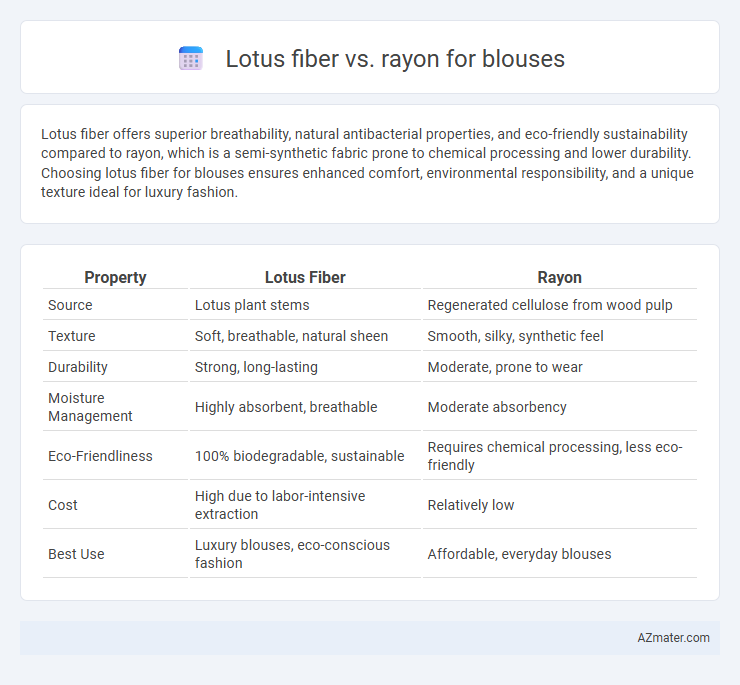Lotus fiber offers superior breathability, natural antibacterial properties, and eco-friendly sustainability compared to rayon, which is a semi-synthetic fabric prone to chemical processing and lower durability. Choosing lotus fiber for blouses ensures enhanced comfort, environmental responsibility, and a unique texture ideal for luxury fashion.
Table of Comparison
| Property | Lotus Fiber | Rayon |
|---|---|---|
| Source | Lotus plant stems | Regenerated cellulose from wood pulp |
| Texture | Soft, breathable, natural sheen | Smooth, silky, synthetic feel |
| Durability | Strong, long-lasting | Moderate, prone to wear |
| Moisture Management | Highly absorbent, breathable | Moderate absorbency |
| Eco-Friendliness | 100% biodegradable, sustainable | Requires chemical processing, less eco-friendly |
| Cost | High due to labor-intensive extraction | Relatively low |
| Best Use | Luxury blouses, eco-conscious fashion | Affordable, everyday blouses |
Introduction to Lotus Fiber and Rayon
Lotus fiber, derived from the stems of lotus plants, is a rare, eco-friendly textile known for its lightweight texture, natural sheen, and breathability, making it ideal for summer blouses. Rayon, a semi-synthetic fiber made from cellulose, offers smoothness and excellent draping properties but involves chemical processes that impact sustainability. Choosing lotus fiber over rayon emphasizes natural origin and biodegradability, catering to eco-conscious fashion trends.
Origins and Production Processes
Lotus fiber is derived from the stems of the lotus plant, primarily harvested in Southeast Asia, where each fiber is hand-extracted through a labor-intensive process that involves pulling and twisting the fibrous strands before drying. Rayon, a semi-synthetic fiber, originates from cellulose extracted from wood pulp or cotton linters, and undergoes chemical treatment and regeneration to form viscose fibers. The natural, eco-friendly extraction of lotus fiber contrasts with the chemically intensive manufacturing of rayon, influencing their sustainability and texture in blouse applications.
Environmental Impact Comparison
Lotus fiber production uses natural extraction methods requiring minimal chemicals, significantly reducing water pollution compared to rayon, which relies on intensive chemical processing from wood pulp. The biodegradability of lotus fiber is higher, decomposing quickly without releasing harmful substances, while rayon often involves toxic solvents like carbon disulfide that pose environmental and health hazards. Lotus fiber's sustainable cultivation promotes biodiversity and conserves water resources, whereas rayon's manufacturing contributes to deforestation and high water consumption.
Texture and Comfort Differences
Lotus fiber offers a unique, coarse texture with natural stiffness, making it durable yet breathable, while rayon provides a smooth, silky feel that drapes effortlessly on the skin. Moisture-wicking properties in lotus fiber enhance comfort in hot climates, whereas rayon's synthetic nature can sometimes trap heat and cause stickiness. The natural elasticity of lotus fiber contributes to a slightly rougher but more resilient fabric, contrasting with rayon's soft and often delicate texture ideal for lightweight, flowy blouses.
Breathability and Moisture Management
Lotus fiber exhibits superior breathability compared to rayon due to its natural hollow structure, which enhances air circulation and keeps the skin cool. Its inherent moisture-wicking properties efficiently absorb and release sweat, maintaining dryness and comfort throughout the day. Rayon, while soft and smooth, tends to retain moisture longer, making lotus fiber a preferable choice for blouses requiring better breathability and moisture management.
Durability and Longevity
Lotus fiber exhibits superior durability compared to rayon, maintaining its strength and integrity even after multiple washes, making it ideal for long-lasting blouses. Rayon tends to degrade faster due to its semi-synthetic cellulose structure, which weakens with exposure to moisture and friction. Choosing lotus fiber ensures a blouse with enhanced longevity, sustaining fabric quality and reducing wear over time.
Dyeing and Color Retention
Lotus fiber exhibits superior dye absorption due to its natural porous structure, resulting in vibrant and long-lasting colors for blouses, while rayon's synthetic composition tends to fade more quickly over time. The dye molecules bond more effectively with lotus fiber, enhancing color retention even after multiple washes and exposure to sunlight. Additionally, lotus fiber blouses maintain their hue without requiring harsh chemical dyes, making them an eco-friendly choice compared to rayon.
Cost and Market Availability
Lotus fiber blouses are significantly more expensive than rayon due to the labor-intensive extraction process and limited production, making them a niche luxury item. Rayon blouses offer a more affordable alternative with widespread market availability, benefiting from established manufacturing and distribution networks. Consumers looking for budget-friendly options typically choose rayon, while lotus fiber appeals to those prioritizing exclusivity and sustainability.
Suitability for Blouse Design
Lotus fiber offers a unique texture and natural sheen that enhances blouse design with breathability and eco-friendliness, making it ideal for summer wear and luxury apparel. Rayon, known for its smoothness and drape, provides versatility in blouse design by mimicking silk at a lower cost while offering excellent color retention and comfort. The choice between lotus fiber and rayon depends on the desired aesthetic, sustainability preference, and performance requirements for the blouse.
Final Verdict: Which is Better for Blouses?
Lotus fiber offers superior breathability and eco-friendliness compared to rayon, making it an excellent choice for blouses in hot and humid climates. Rayon, however, provides a smoother texture and more vibrant dye absorption, ideal for fashion-focused, lightweight blouses. For those prioritizing sustainability and natural texture, lotus fiber is better, while rayon suits users seeking a softer feel and vivid colors.

Infographic: Lotus fiber vs Rayon for Blouse
 azmater.com
azmater.com